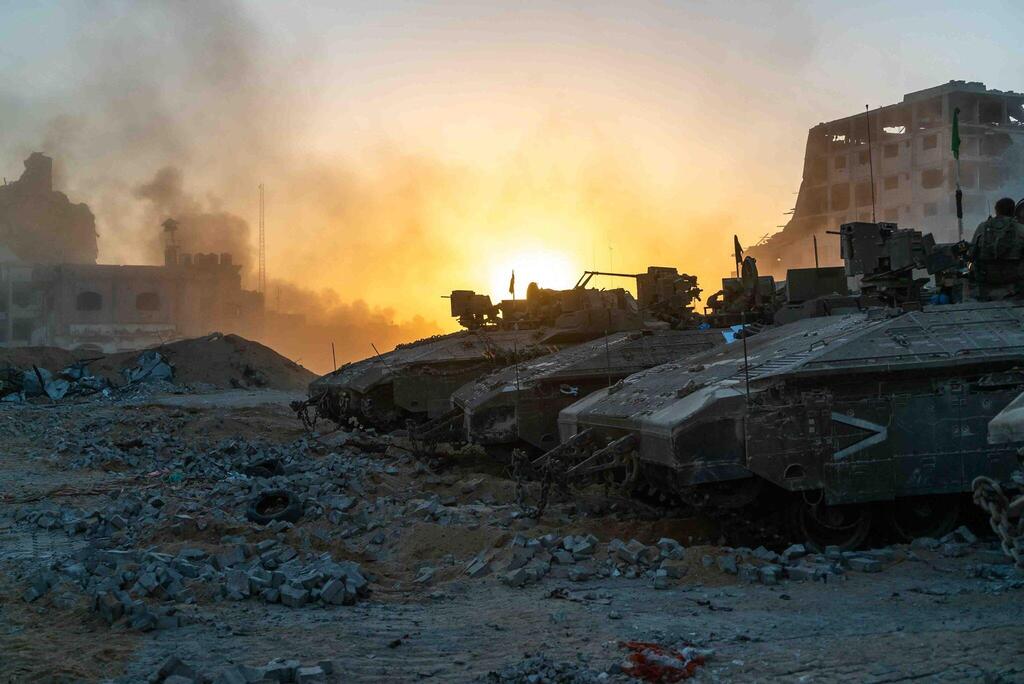
ISRAEL AT WAR
Israel halting export of tanks, rebuilding armored forces amid Gaza war
A deal to sell hundreds of IDF tanks to Europe was canceled amid the decision to re-increase the armored forces. Israel is buying dozens of D9 bulldozers and adapting them to be autonomous.
Israel has canceled the planned exportation of hundreds of Merkava battle tanks to foreign armies, including those in Europe, due to the war in Gaza and moves to expand IDF readiness for war in Lebanon. The tanks in question are no longer used by the IDF and were replaced in the past two decades by more advanced ones. Additionally, in recent months the development of a new tank named “Barak" was completed, based on the Merkava tank, and some have been in use by several battalions since before the war.
The decision to halt the export was made by the Director-General of the Defense Ministry, Major General Eyal Zamir. The decision came after significant negotiations between representatives of SIBAT, the ministry’s International Defense Cooperation directorate, and procurement representatives from foreign armies. The parties were on the verge of finalizing a historic deal for the first export of Israeli tanks worth tens of millions of dollars.
Security sources told Calcalist that Zamir's decision was made before the Gaza war and proved to be justified in light of the crucial role played by armored forces in the ground campaign. The tanks and armored vehicles have undergone maintenance since the outbreak of the war in Ukraine and even more so since the war in Gaza, where they play an integral role in the ongoing fighting, in close and coordinated activity with infantry and the air force.
Returning to tank battalions
Following the decision to halt the export, the IDF immediately began establishing an armored battalion of reserve soldiers, consisting of several dozen of the tanks. In the past decade, some units in the armored and ground forces were disbanded due to efficiency considerations and preference for new technologies. A senior military official told Cacalist that "this is not the time to part with tanks, especially when there is a high probability that more will be needed in the future. Older tanks are being improved and adapted to the operational needs of the IDF."
The tanks' production is overseen by the Merkava and Armored Vehicles Directorate (MANTAK), and manufacturing takes place at the Rehabilitation and Maintenance Center (MASHA). At the same location, Namer tanks are being produced based on Merkava, as well as the new "Eitan,” the first of which were delivered to the IDF in the past year as part of the gradual replacement process for the outdated M-113s.
Before the ground campaign in Gaza, the IDF and the Ministry of Defense added metal skirts above the tanks as protection against drone attacks that seek to bypass the active defense systems. Hamas used this method during its surprise attack on 7/10 to hit several IDF tanks and APCs. A senior military official told Cacalist that most of the tanks and APCs damaged at the beginning of the attack were quickly repaired and returned to the front lines. In addition, about 85 new vehicles have been produced since the beginning of the war, including tanks, Eitan APCs, and Namers. This is an unprecedented production output in just a month and a half. Nearly 100 armored vehicles have been produced in a month and a half, compared to the normal production rate for the IDF of about 100 armored vehicles in an entire year.
Unmanned bulldozers
In addition to increasing the number of armored vehicles, the Ministry of Defense has recently initiated the urgent procurement of dozens of D9 heavy bulldozers, which perform extensive engineering work, exposing tunnel shafts and opening axes and access roads threatened by explosive devices.
These bulldozers can withstand large amounts of fire, primarily anti-tank missiles and RPGs, while leading the forces' movement within Gaza. These vehicles have been adapted with metal roofs since the beginning of the war to reduce their vulnerability to attack by explosive drones. Some of the D9 bulldozers are currently undergoing adaptation processes for autonomous or semi-autonomous operations, allowing complex operations in high-risk areas without the need for a driver. A system, called "Panda," developed in recent years by Alta Systems and the IDF, enables the autonomous capabilities.
The Ministry of Defense has not disclosed the total cost of the system, but recent data from the ministry indicates that since the beginning of the war, it has placed orders totaling NIS 4 billion ($1.08 billion) to defense industry companies.














